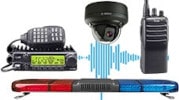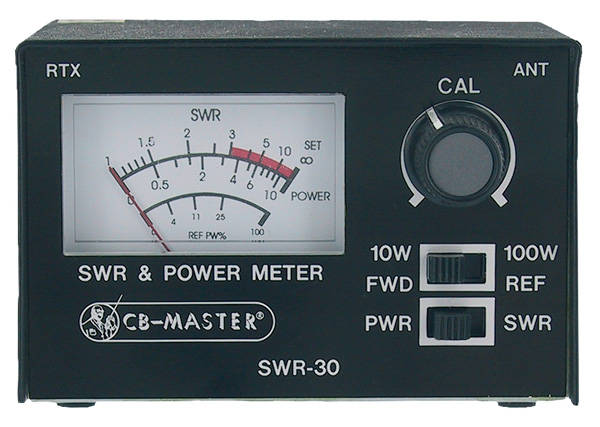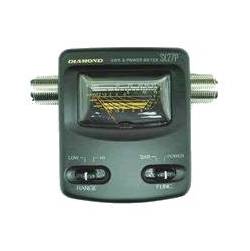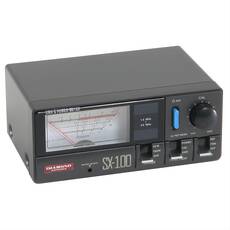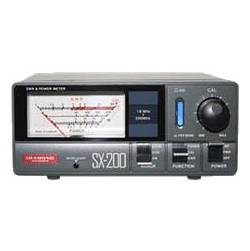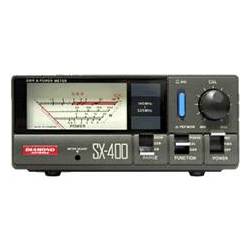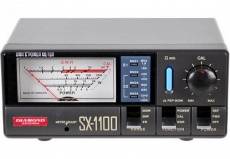SWR Meter, Antenna Tuner
The most common measuring instrument in radio engineering is the standing wave meter, also known as the SWR meter. This antenna tuner measures the power sent from the radio to the antenna and how much of that power is reflected back. SWR, which stands for Standing Wave Ratio. Read more...
• Frequency: 3,5-50 Mhz (SWR), 26-30 Mhz (Power)
• Impedancia: 50 Ohm
• Measurable power: 0-10W
• Accuracy: :±5%
• Connection: UHF-female
• Dimensions: 85 x 55 x 30 mm
• Frequency: 140-150 / 430-450 Mhz
• Impedancia: 50 Ohm
• Power display range: 15-60W
• Minimum power at SWR measurement: 0-60W
• Insertion loss: less than 0.3dB
• Measurement function: forward RF power, SWR
• Connection: UHF-female
• Dimensions: 64 x 75 x 31 mm
• Weight: 200 g
• Frequency: 144-470 Mhz
• Impedancia: 50 Ohm
• Power display range: 30-300W
• Minimum power at SWR measurement: 3W
• Accuracy: :±10%
• Connection: UHF-female
• Dimensions: 85 x 87 x 95 mm
• Weight: 270 g
• Frequency: 1.6-60 Mhz
• Impedancia: 50 Ohm
• Power display range: 30 / 300 / 3000W
• Minimum power at SWR measurement: 3W
• Insertion loss: less than 0.1dB
• Measurement function: forward RF power, reflected RF power, SWR, PEP monitor
• Accuracy: :±10%
• Connection: UHF-female
• Dimensions: 155 x 63 x 103 mm
• Weight: 640 g
• Frequency: 1.8-200 Mhz
• Impedancia: 50 Ohm
• Power display range: 5 / 200 / 200W
• Minimum power at SWR measurement: 4W
• Insertion loss: less than 0.15dB
• Measurement function: forward RF power, reflected RF power, SWR, PEP monitor
• Accuracy: :±5-15%
• Connection: UHF-female
• Dimensions: 155 x 63 x 103 mm
• Weight: 540 g
• Frequency: 144-525 Mhz
• Impedancia: 50 Ohm
• Power display range: 5 / 200 / 200W
• Minimum power at SWR measurement: 4W
• Insertion loss: less than 0.1dB
• Measurement function: forward RF power, reflected RF power, SWR, PEP monitor
• Accuracy: :±5-20%
• Connection: N-female
• Dimensions: 155 x 63 x 103 mm
• Weight: 540 g
• Frequency: 1.8-525 Mhz
• Impedancia: 50 Ohm
• Power display range: 5 / 200 / 200W
• Minimum power at SWR measurement: 1-4W
• Insertion loss: less than 0.2dB
• Measurement function: forward RF power, reflected RF power, SWR, PEP monitor
• Display illumination: Meter illumination and LED function display require external DC13.8V power supply
• Accuracy: :±10%
• Connection: N-female
• Dimensions: 155 x 63 x 103 mm
• Weight: 630 g
• Frequency: 1.8-160 Mhz (S1), 430-450, 800-930, 1240-1300 Mhz (S2)
• Impedancia: 50 Ohm
• Power display range: 5 / 200 / 200W
• Minimum power at SWR measurement: 1-2W
• Insertion loss: less than 0.2dB
• Measurement function: forward RF power, reflected RF power, SWR, PEP monitor
• Display illumination: Meter illumination and LED function display require external DC13.8V power supply
• Accuracy: :±10%
• Connection: 2xUHF female (S1), 2xN-female (S2)
• Dimensions: 155 x 63 x 103 mm
• Weight: 890 g
This value shows how much of the radio frequency power is coming out of the radio. Ideally, it is 100 percent, meaning there is no reflection. This means that all of the transmitter power is radiated out.
Why is a SWR meter and antenna tuner important?
Before using your newly purchased antenna, it is essential to tune it. To make sure that this is done perfectly, we can measure the SWR, the standing wave ratio. By default, the radio frequency signal propagates from the radio's output stage to the antenna, where it is then radiated out.
If the connection is not correct, or the antenna is not tuned to exactly the right frequency, only a small part of the power is transmitted into the ether, and the rest is reflected. A small amount of reflection "only" reduces the efficiency, but a larger amount of reflection can destroy the output.
What types of antennas can be tuned using the SWR meter?
Any type, since the standing wave ratio meter is used to measure the matching of the transmitter and antenna. The SWR meter is always connected to the location of an antenna where you want to determine its value. If you want to check the antenna itself for correctness, you should connect the SWR meter between the antenna cable and the antenna input. In this case we have to set the meter to SWR2. If you want to measure that the transmitter is well matched to the antenna cable, it is also possible, in which case you should connect the meter to the SWR1 position.
To get the best performance, how often should you check your antenna setup?
If the antenna is moved, which in practice means perhaps to another rooftop or, in the case of a CB antenna, from the top of the truck to the side, then the measurement should be made again. Why is this necessary? Because the antenna's surroundings have a big influence on its radiation properties, and with it the SWR.
What is the important value of the SWR meter and how does it affect the radio link?
We can determine this by setting the radio to the lowest frequency. We then measure the SWR value. Then the measurement is made at the highest frequency. Then the values obtained are evaluated. If the lower frequency channel has a more favourable number than the higher one, the antenna is too long. In this case, the antenna size should be carefully reduced, and then the tuning can be continued by repeating the measurements until the best SWR value is obtained.
But what if this value is higher? In that case the antenna is too short. This is the more awkward situation because we can't make a longer one. Generally speaking, we should mention that at amateur level, we can radio with a SWR of 1.5-2 without any further problems. However, be careful not to switch on the radio for even a short time with an unloaded antenna, because the output stage will not be able to deliver the power and will be destroyed.
How to use the SWR meter as a beginner and advanced?
It is important to know that the SWR meter for amateur purposes is not laboratory accurate, but it is perfectly suitable for home use. Cheaper instruments of this type are only functional in the 2-30 MHz range. SWR meters with more serious performance, capable of operating at 160 or even 450 MHz, are already used by professional radio operators.
What frequency ranges is the antenna tuner suitable for?
Due to their design, SWR meters can only operate within certain power limits. It is good to know that SWR meters designed for high power output stages are not sensitive enough to measure the matching of handheld radios, and if they are, this type of meter may fail from the higher power being passed through it because it is drawing too much power from the power line.
The standing-wave meter was developed more for radio amateurs. These devices measure mostly in the frequency range of 2 to 30 MHz, but can be used with good accuracy up to 50 MHz. The size of the directional couplers of SWR meters is adapted to the wavelength. Antenna tuners designed for shortwave bands are not optimal for the URH bands. For the 144 and 432 MHz bands, it is recommended to use a separate SWR meter.
What is the difference between passive and active antenna tuning?
The active antenna has a built-in amplifier. It is powered and controlled via the TV cable. Note that these types of antennas are not reliable and can fail due to moisture in the circuit or weather conditions. Therefore, this type of antenna needs to be tuned much more often. In this case, it is better to use a passive antenna because it has its own external amplifier. The probability of failure of a passive antenna is minimal if used properly.
The role of SWR meters and antenna tuners is unavoidable in telecommunications. SWR meters can be used to detect most problems and thus find a solution to the problem in a short time. See our range of SWR meters and antenna tuners in our webshop.

